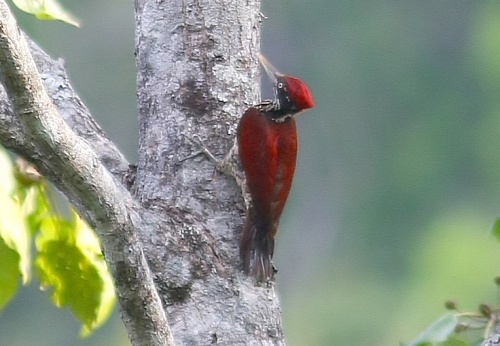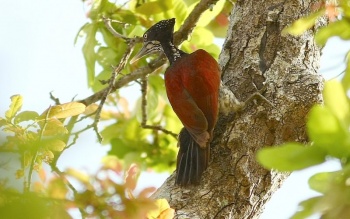| This article is incomplete. This article is missing one or more sections. You can help the BirdForum Opus by expanding it. |
Alternative name: Crimson-backed Goldenback
- Chrysocolaptes stricklandi
Identification
This Flamback is about 11.5 ; tail 3.5 ; wing 5.9 ; tarsus 1.1; bill from gape 1.9. Back, scapulars, and outer surface of wings, except primary-coverts and outer webs of primaries, dull crimson, edges of feathers brighter, rump also brighter. In all other respects this species resembles C. gutticristatus except that there is everywhere more black and less white, there are only white spots on the back of the neck, and the sides of the head above the malar region and of the neck are almost all black, the superciliary stripe being represented by a row of white spots. The black borders of the breast-feathers are very broad. Sexual distinctions as in C. gutticristatus.Bill brownish or olivaceous at the base, greenish white in the middle, the tip dusky; iris yellowish white; legs and feet greenish' slate.
Distribution
Endemic to Sri Lanka
Taxonomy
This is a monotypic species.
Has been considered conspecific with Greater Flameback in the past.
Habitat
This Woodpecker is found in forests almost throughout the island, on both hills and lowlands Forest and well wooded areas up to 2100m.
Behaviour
This species haunting a nest-hole high up a large tree in January in such a manner as to indicate that they had young.
References
- Clements, JF. 2011. The Clements Checklist of Birds of the World. 6th ed., with updates to August 2011. Ithaca: Cornell Univ. Press. ISBN 978-0801445019. Spreadsheet available at http://www.birds.cornell.edu/clementschecklist/downloadable-clements-checklist
Recommended Citation
- BirdForum Opus contributors. (2024) Crimson-backed Flameback. In: BirdForum, the forum for wild birds and birding. Retrieved 1 November 2024 from https://www.birdforum.net/opus/Crimson-backed_Flameback





